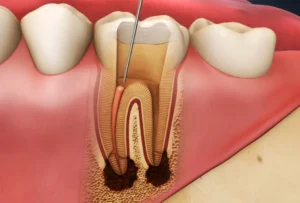Which would you rather do: go swimming with sharks or have a root canal?
Over 40 percent of U.S. adults in an October 2019 survey would rather take their chances with Jaws than undergo the restorative procedure. They would also rather spend an hour in a room with 10 spiders or sing the national anthem at a sporting event than face their fear of root canals.
As you can see, root canals have a public relations problem! Their bad reputation, however, is mostly a remnant from the past, when the treatment used to be far more painful.
With modern dental technique and anesthetics, root canals aren’t any more difficult than having a cavity filled.
Here at Hancock and Johnston Dentistry, we are committed to working with you to find the right dental care for your unique situation.
What is a Root Canal?

Root canal treatment (a nonsurgical root canal) is used to remove bacteria from the infected root of a tooth. This is an effort to save a tooth due to cracked teeth from injuries, deep cavities, or even issues with previous fillings.
Underneath the top layers of enamel and dentin, your tooth includes a soft tissue called pulp. The pulp is composed of blood vessels, nerves and connective tissue that helps the teeth grow during development. Once developed, however, teeth can exist without the pulp.
| ROOT CANAL STEPS |
|
|
|
|
If this nonsurgical root canal is not enough to save your tooth (usually because of small fractures, hidden canals or calcium deposits), you may be recommended for endodontic surgery, but there’s no need to worry about this because technology has also made this additional treatment comfortable.
Nonsurgical root canals have more than a 95 percent success rate, and many teeth repaired with this method can last a lifetime.
All the same, you may be wondering if there are any alternatives to a root canal.
Root Canal Alternatives
Depending on the health of the tooth (and the age of the patient), there are a few other options outside of a root canal treatment.

Direct Pulp Capping
This procedure may be recommended when you have severe damage or decay that only minimally exposes the pulp, and as a way to avoid a full root canal or extraction in the future.
A mineral barrier (typically calcium hydroxide or mineral trioxide aggregate [MTA]) is placed over the exposed pulp to promote tissue repair. Then the tooth is filled. This is less invasive than a root canal, and less costly.
On the other hand, this method is most likely to succeed when the exposed pulp is healthy and the patient is young. And there’s still a chance that root canal treatment will be needed later on.
Pulpotomy
This treatment is focused on pulp removal — it is similar to pulp capping but different from pulp removal in a root canal (called pulpectomy). In a pulpotomy, the root canals and tooth nerve are preserved (unlike in a root canal).
The infected pulp is removed, then a material (formocresol, calcium hydroxide, MTA) is added for healing and bacterial growth prevention. Afterward, the dentist fills the tooth and places a crown to protect from damage.
Pulpotomies are usually performed on children who still have their baby teeth or underdeveloped adult teeth, where the root still isn’t formed. In adults, this is typically an “emergency root canal” to relieve pain until an actual root canal can be done.
Tooth Extraction and Dental Implants, Bridges or Dentures
Some people say they’d rather pull their teeth than endure a root canal — but as your dentist, we strongly encourage you to save your natural teeth if possible.
Tooth extraction is a last resort. We would only recommend this option if decay is so advanced that a root canal wouldn’t work at all.
In the case of an extraction, you have three options for restoring your teeth and chewing function:
- Dental implants: A dental implant is a fixture placed directly into your jawbone. After the area heals, an artificial tooth is attached to the implant.
- Dental bridge: A bridge is an artificial tooth that’s attached to crowns designed to fit on the neighboring teeth.
- Removable partial denture: An artificial tooth with a base that matches the color of your gums and can be secured by fixtures that connect to neighboring teeth.
A Final Word
Although talk of a root canal may still strike fear in your heart, please note that the pain associated with the procedure is largely mythical thanks to dental advances in recent years. More than 41,000 root canals are performed each day, at a rate of more than 15 million per year.
In fact, it’s more painful to avoid a root canal and live with infection. If you’re experiencing tooth discomfort right now, contact your favorite restorative dentists in Lubbock at Hancock and Johnston Dentistry for a consultation. We will look at your unique dental situation before deciding on a custom treatment plan. And even if it comes to a root canal, we can assure you that we always take your comfort into account — and it’s definitely not as scary as swimming with a bunch of sharks!

